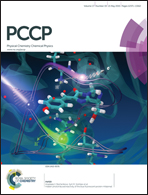Potential-dependent structures investigated at the perchloric acid solution/iodine modified Au(111) interface by electrochemical frequency-modulation atomic force microscopy
Abstract
Electrochemical frequency-modulation atomic force microscopy (EC-FM-AFM) was adopted to analyze the electrified interface between an iodine modified Au(111) and a perchloric acid solution. Atomic resolution imaging of the electrode was strongly dependent on the electrode potential within the electrochemical window: each iodine atom was imaged in the cathodic range of the electrode potential, but not in the more anodic range where the tip is retracted by approximately 0.1 nm compared to the cathodic case for the same imaging parameters. The frequency shift versus tip-to-sample distance curves obtained in the electric double layer region on the iodine adlayer indicated that the water structuring became weaker at the anodic potential, where the atomic resolution images could not be obtained, and immediately recovered at the original cathodic potential. The reversible hydration structures were consistent with the reversible topographic images and the cyclic voltammetry results. These results indicate that perchlorate anions concentrated at the anodic potential affect the interface hydration without any irreversible changes to the interface under these conditions.


 Please wait while we load your content...
Please wait while we load your content...